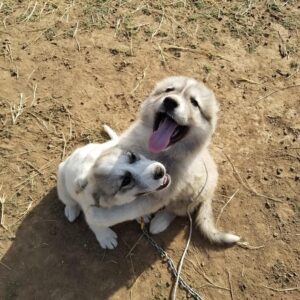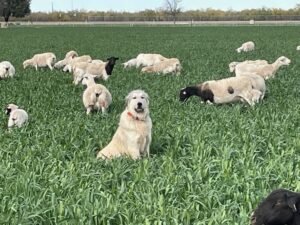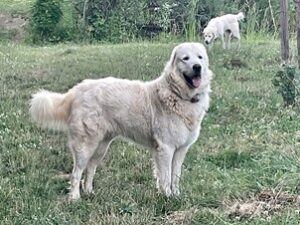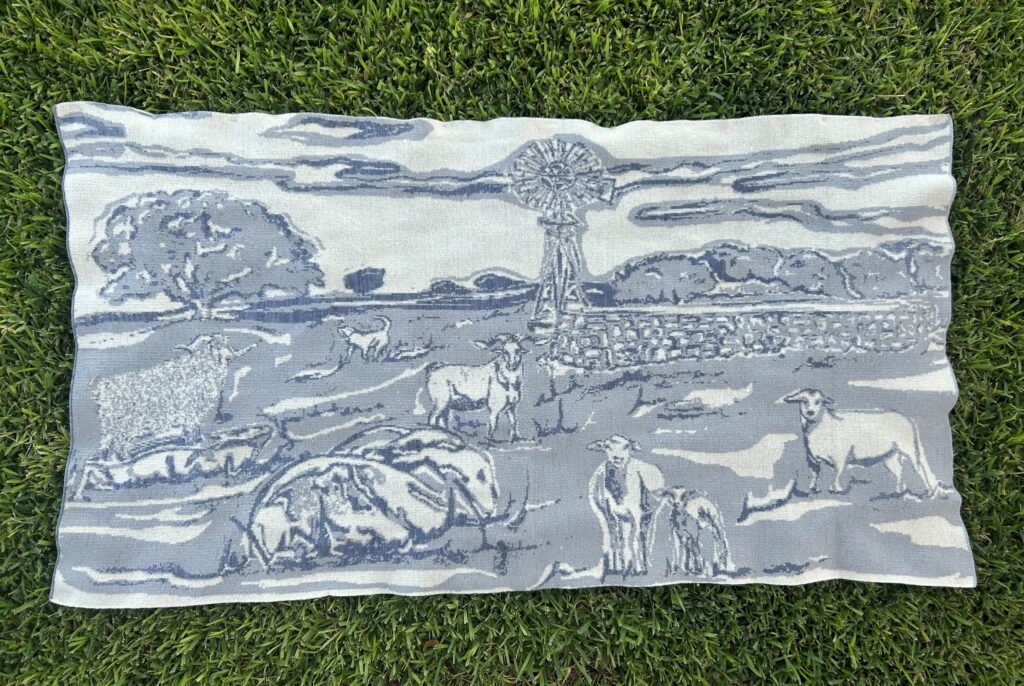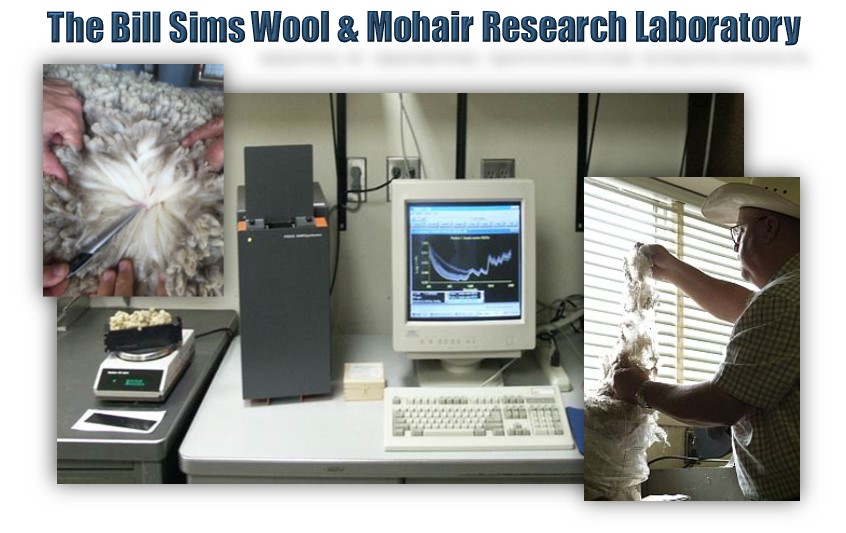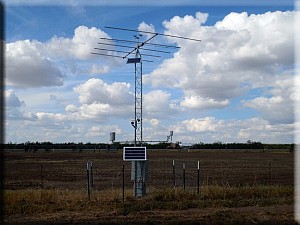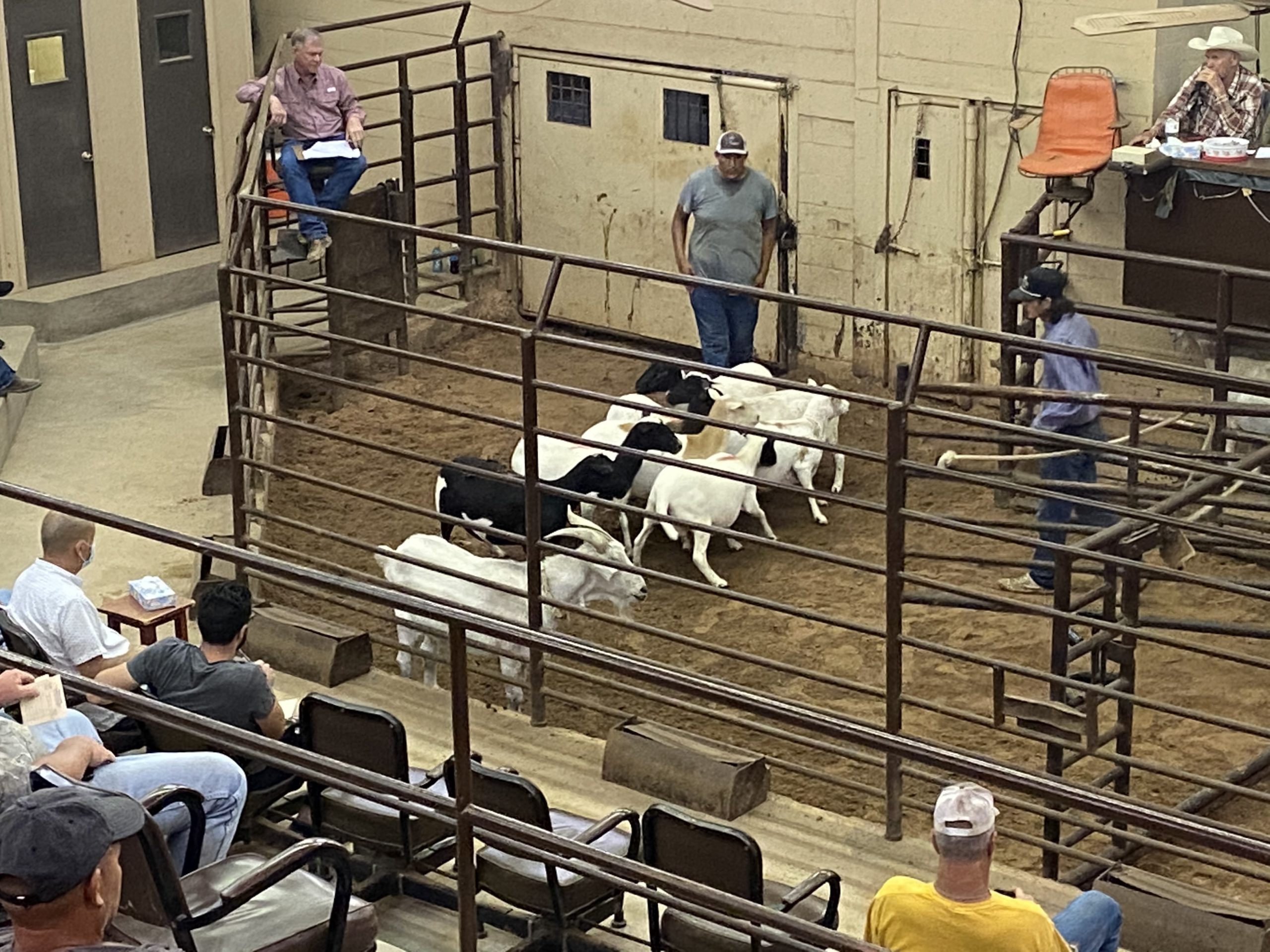I received some sad news one afternoon last month. One of our LGDs, Doc Holiday, aka “Doc” from round three of the bonding project, was hit and killed by a vehicle outside of the AgriLife Center on Highway 87 N. Those following our Facebook page may remember seeing posts about Doc and Thelma hugging as puppies, roaming long distances from the ranch in Menard, and finally receiving invisible fence training to stop the roaming. The invisible fence training worked well for these LGDs, and their wandering almost completely stopped for over a year.
Doc and Thelma found a hole in their pasture fence last month and traveled across another pasture and through its boundary fence to a deer carcass on the side of the highway. A dead deer’s aroma on the highway median was too tempting for them. Doc was struck while he was eating the deer carcass and killed.
Luckily, Thelma was not injured, and she returned to her pasture immediately after the event
based on her GPS tracker data. While geofences and alerts are set up to notify us when dogs leave their pastures, the event happened too quickly to receive a timely notification that they had left.
We are in the process of switching over to the LoRa tracking system at the Center, but it was not soon enough to stop this event from occurring. I encourage producers to use the latest GPS trackers and software to help prevent the loss of good LGDs like Doc. Doc was a favorite LGD of many of the employees at the AgriLife Center. You will be missed, Doc! Last day on guard 12-5-23.
AgriLife Livestock Guardian Dog Program: Update and Events
Our next online seminar will be on Feb. 15 at 3 pm. The online workshop will be on the Maremma Breed and will be presented by long-time breeder Sarah Letts, owner of Sky Island Farm LLC in California. Letts is a past board president of the Maremma Sheep Dog Club of America and will discuss the distinct types of Maremma dogs and their characteristics in the online seminar. Check out the events page on our Facebook page for more information and to register for the event. You can also register for the online workshop on our website.
The Texas LGD Association (TLGDA) has added a Facebook group page so that producers can access help and information directly from the membership. Members can also post advertisements for pups and dogs directly instead of first submitting the information to board members. The group page is currently open to anyone interested in LGDs but will become a member-only resource in the future. The TLGDA website will soon be set up for member-only access. If you haven’t joined the association, now is the time to ensure you have access to breeders and resources from the organization on Facebook and the website!
The TLGDA is also adding directors at large to increase awareness of the association at livestock and agriculture events across the state. Three of the five regions have been filled, but the association is still looking for two more directors. If you are a member of the association and are interested in taking on a leadership role, please get in touch with one of the board members or myself.
LGDs and Roaming – Part I
In certain regions, roaming livestock guardian dogs can pose a significant problem for producers, resulting in the loss of LGDs. But why do these dogs roam, and is there a way to prevent it? LGDs roam for patrolling, marking territory, and keeping predators at bay. Some breeds, including the Pyrenean Mastiff and the Maremma, have been observed to roam less based on anecdotal evidence. During bonding, boundary training with hot wire and invisible fencing can effectively prevent excessive roaming. However, it’s crucial to note that each dog is unique, and the behavior of a particular breed may not be consistent across all individuals.
Why Do Livestock Guardian Dogs Roam?
Livestock guardian dogs were specifically bred to cover extensive distances, mark their territory, patrol for predators, and gather information about their surroundings. These dogs protect livestock and will do whatever it takes to keep them safe. Roaming is a significant part of their strategy for deterring predators, as they mark their territory and leave their scent to warn potential threats, engaging with them from a safe distance away from the livestock. However, in modern times, roaming can be incredibly hazardous for livestock guardian dogs. Many ranchers no longer require them to roam far and wide due to the potential dangers involved.
Livestock guardian dogs that do roam typically patrol the perimeter of their territory, marking it as their own and investigating anything that seems out of the ordinary. They may even chase down predators that pose a threat to their livestock. Some breeds of livestock guardian dogs can roam for miles, covering over 5,000 acres of land. This characteristic makes them very effective at protecting the animals under their care. Ranchers with large properties, high predator loads, or scattered livestock may need roaming guardian dogs to keep their animals safe. It is better to consider having a pack of dogs that includes roaming and close-guarding breeds for maximum protection.
Check back next month for the rest of this article on LGDs and roaming!
Bonding Project Update
Round Five Dogs
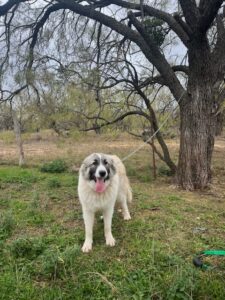
Maverick waiting for his invisible fence collar batteries to be changed. AgriLife picture courtesy, Saldana, 2023
The pups from round five have all been doing well on their ranches. None of the dogs have left their pasture boundaries to date, which is normal now. The non-hot wire bonded pups usually start roaming or patrolling outside their boundaries after being at their new ranches for about six weeks. I’m hoping that none of this round of dogs roam. The Komondors were bonded without hot wire and were generally with their livestock when observed in the field and when GPS data was reviewed. Hopefully, this is a breed characteristic that would be helpful to know for producers. The Komondors were separated, with Belle and Pearl being sent to Uvalde and Mabel being sent to Comstock. Viper is on a ranch in Ft. Davis. Goose and Maverick are still at the AgriLife Center, waiting to go to their new home at the Stephenville AgriLife Center.
In closing
If you enjoyed this monthly LGD blog, please don’t forget to subscribe to it with this link: The Guardian Way | Texas A&M AgriLife Research and Extension Center at San Angelo.
To provide feedback on this article or request topics for future articles, please contact me at bill.costanzo@ag.tamu.edu or 325-657-7311.
The Texas A&M AgriLife Livestock Guardian Dog Program is a cooperative effort by Texas A&M AgriLife Research and the Texas Sheep and Goat Predator Management Board. Follow us on our social media sites and share them with your friends and family!
Facebook, Instagram, YouTube: @TAMUlivestockguarddog
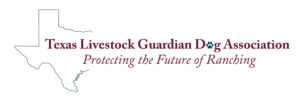 Do not forget to check out the Texas LGD Association online! Follow the organization on Facebook or YouTube at @TexasLGDAssociation, or check out their website!
Do not forget to check out the Texas LGD Association online! Follow the organization on Facebook or YouTube at @TexasLGDAssociation, or check out their website!

